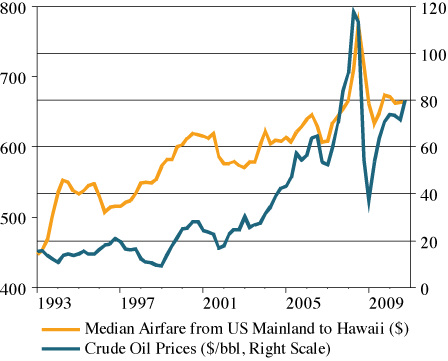Oil prices have fluctuated widely in recent years. In our recent County Forecast Report, we discussed how oil affects the overall economy. Because fuel costs represent about 40% of airline expenses, they can have a large effect on the profitability and behavior of airlines, and ultimately the Hawaii tourism industry.
The price of oil has a direct impact on the cost of travel. However, airfares do not move by as large a margin as the swings in oil prices. There are several reasons for this. First, as we all know, airlines can compensate for rising oil prices by adding various fees and surcharges to the final price of the trip. Second, airlines can implement strategies that mitigate the impact on costs. To avoid losses in the face of an oil shock, airlines often eliminate underutilized flights. We see this clearly in data for Hawaii, where the capacity utilization of flights to the Islands has increased from about 75% in the “cheap oil era” of early 1990’s to about 85% today. This allows them to operate more profitably at a given cost of oil.

We also observe that airfares often come down more slowly than they went up, once oil prices decline. Typically, when oil prices start to recede from high levels, upside risks linger for an extended period. As a result of this uncertainty, airlines do not immediately reverse the increase in fares, fees and surcharges, and do not rush to replenish the supply of passenger-seats. This asymmetric behavior of airlines implies that travel can remain expensive well beyond an oil price peak.
High oil prices also have important indirect effects on airline travel. High energy costs reduce discretionary household income, undermining the willingness to travel. If the oil shock is followed by a recession, unemployment rises, further reducing the number of households who can afford to travel. And conditions for travel may not immediately improve when oil prices start falling: while oil price increases have often been associated with recessions, oil price decreases have not led to corresponding economic expansions. In fact, UCSD Professor James Hamilton has found that the largest drag on the economy occurs four quarters after oil peaks.
UHERO is conducting ongoing research on the impact of oil prices on the Hawaii visitor industry. Our preliminary results indicate that changes in oil prices and in US economic activity both have significant impacts on the growth rate of US visitor arrivals. Specifically, a 10% decrease in oil prices implies a 0.7% increase in US visitor arrivals, and a 1% increase in US employment leads to a 2.4% increase in US visitor arrivals. High oil prices likely contributed to the softening of Hawaii arrivals in the first half of this year. Likewise, lower oil prices will be helpful going forward. But poor prospects for US employment and output growth mean that a sharp recovery for travel will not occur anytime soon.
— Peter Fuleky and Qianxue Zhao